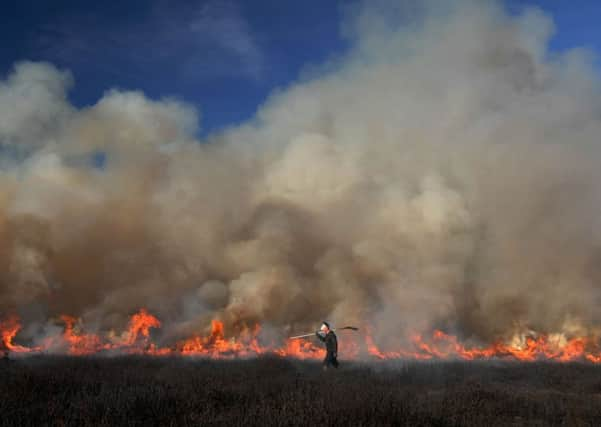Moorland burning ‘threatens protected landscape’


For the first time, a detailed map of where moorland burning has taken place in Britain has been produced using ten years of data, in a study led by the RSPB Centre for Conservation Science. It shows that special conservation areas are bearing the brunt of the controversial practice - which has increasingly been used to help manage moorland over the last decade.
Using aerial photography and satellite images, researchers detected burning in 55 per cent of the Special Areas of Conservation and 63 per cent of the Special Protection Areas that it assessed, and they found significantly more burning took place within them compared to comparable moorlands elsewhere.
Advertisement
Hide AdAdvertisement
Hide AdSuch sites are designated by the EU for their conservation importance, and governments are charged with protecting them from damage and ensuring they are restored, yet many are in “unfavourable” condition, the RSPB said, largely as a result of burning.
Some 45,000 one-kilometre squares were mapped across England, Scotland and Wales. Burning has found to be practiced in 8,551 of them and the number of “burns” had increased by 11 per cent in each year between 2001 and 2011.
The RSPB said this had a damaging effect on areas of deep peat - known as blanket bog - which capture and store carbon from the atmosphere. A third of burning took place on deep peat soils in England and Scotland.
But the Moorland Association maintained that burning was an essential means of managing moorlands, to stimulate the growth of fresh vegetation which offers grazing fodder for sheep and red grouse, while providing habitats to animal species; not just for red grouse to benefit the recreational shooting scene.
Advertisement
Hide AdAdvertisement
Hide AdDr David Douglas, senior conservation scientist at RSPB Scotland and lead author of the study, said: “Upland ecosystems are highly sensitive to burning practices. Knowing how much burning takes place and where is crucial to developing sustainable land management policies for these precious environments.”
Upland areas supply about 70 per cent of the UK’s drinking water and burning has been linked to poor water quality in these areas, the RSPB said.
Martin Harper, the charity’s director of conservation, said: “Many of our uplands are in poor condition, due to intensive land management practices. It’s very worrying that burning is increasing, given the damage it can cause and that it occurs in many of our conservation areas.
“Governments and statutory agencies across Britain need to take action to reduce burning in our uplands rather than allowing them to be increasingly damaged year on year.”
Advertisement
Hide AdAdvertisement
Hide AdAmanda Anderson, director of the Moorland Association, said: “It is no surprise that grouse moor management coincides with our most precious landscapes for conservation and 96 per cent are in recovering condition.
“We are already involved, with Government, the RSPB and others, in very exciting practical action on the ground to improve the health of deep peat. This will deliver better water quality, improved carbon storage and more bog biodiversity.”
She said moorland restoration could not be achieved “overnight” and that there were many factors other than burning that meant they needed particular care.
The Moorland Association was playing a leading role in managing the uplands, she said.
Advertisement
Hide AdAdvertisement
Hide AdThe Yorkshire Dales and the North Pennines, as well as to a lesser extent the North York Moors where there is little deep peat, had benefitted from conservation work, Mrs Anderson said.
This had included the reversing of “moorland gripping”, a practice of digging ditches to drain wet areas of heath and blanket bog that was encouraged 30-50 years ago but had damaged wildlife and biodiversity.
Hundreds of hectares of bare peat has also been re-vegetated and work is ongoing to reintroduce Sphagnum moss - “the king of bog plant species” - where it is missing, she said.
A spokesman for Natural England said burning was one of just a range of activities that impact on moorland, and that the government agency recently undertook a series of evidence reviews to improve its understanding of the issues.
Advertisement
Hide AdAdvertisement
Hide AdThe spokesman said: “Burning is a traditional tool to manage heather dominated vegetation. It can be undertaken with little impact on dry heathland vegetation and in many cases is entirely compatible with conservation management.
“On wetter, deep peat habitats that play an important role in storing carbon dioxide there is often a need to consider alternative forms of management. Natural England, Defra and other stakeholders have signed up to an approach which aims to help restore important peatlands and protect them from damaging impacts. “The intensity and location of burning, in addition to restoration measures, are vital elements of this approach. Burning is a tool that can help to reduce the risk of damaging impacts from wildfire and can also assist restoration through reducing the dominance of heather. Any potentially damaging impacts from burning will be reviewed in this approach.”